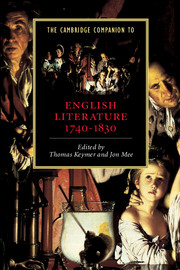Book contents
- Frontmatter
- Part I Contexts and modes
- 1 Readers, writers, reviewers, and the professionalization of literature
- 2 Criticism, taste, aesthetics
- 3 Literature and politics
- 4 Literature, national identity, and empire
- 5 Sensibility
- 6 Theatrical culture
- 7 Gothic
- Part II Writers, circles, traditions
- Index
- Series list
2 - Criticism, taste, aesthetics
from Part I - Contexts and modes
Published online by Cambridge University Press: 28 May 2006
- Frontmatter
- Part I Contexts and modes
- 1 Readers, writers, reviewers, and the professionalization of literature
- 2 Criticism, taste, aesthetics
- 3 Literature and politics
- 4 Literature, national identity, and empire
- 5 Sensibility
- 6 Theatrical culture
- 7 Gothic
- Part II Writers, circles, traditions
- Index
- Series list
Summary
A serious thought standing single among many of a lighter nature, will sometimes strike the careless Wanderer after Amusement only, with useful Awe: As monumental Marbles scattered in a wide Pleasure-Garden (and such there are) will call to Recollection those who would never have sought it in a Churchyard-walk of mournful Yews.
When Edward Young compares his Conjectures on Original Composition (1759) to a garden, he is also doing a number of other things. He is implying that you will get pleasure, rather than only information about it, from his writing. He is suggesting that you will want to wander, rather than march, through his book. And he is reaffirming the flexibility of the kind of writing he is undertaking. Its unity is not like that of the idea of a poem in one of the neo-classical categories, given by prescribed manner or matter; nor is it like that of a philosophical treatise, given by a deductive or inductive logic. It is, instead, like that of a garden, a series of walks, prospects and emblems, in which the designer hopes to make his caprice gratifying, and occasionally instructive, to visitors.
What is criticism, in this period? Only at certain times and in certain places has ‘criticism’, as it now does, primarily designated literary criticism. Between 1740 and 1830 the term’s meanings are complex, for a number of reasons. Not only did literature only by the end of this period come to refer chiefly to works of invention, rather than to a much wider range of the products of the world of letters; but criticism bore a number of more specific senses, all of which in various ways and to various extents interacted with and informed the criticism of invented texts.
- Type
- Chapter
- Information
- The Cambridge Companion to English Literature, 1740–1830 , pp. 24 - 42Publisher: Cambridge University PressPrint publication year: 2004
- 4
- Cited by



